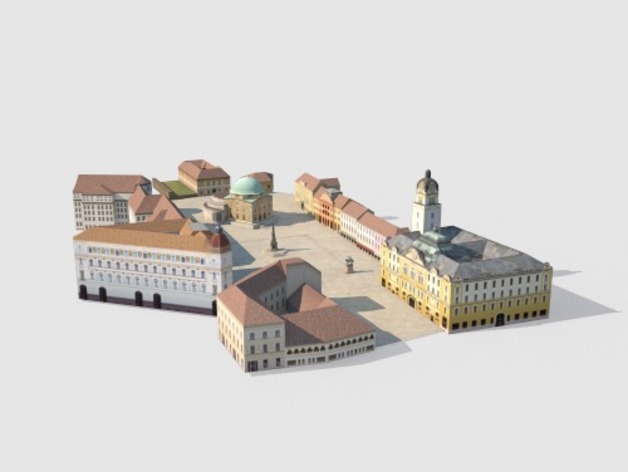
Szechenyi Square - Pecs, Hungary
thingiverse
The square, in its former names Market Square, Main Square, Forum Square is now the touristic, commercial and administrative centre of the inner city of Pécs, where 12 streets meet. The square that used to operate as a marketplace has been called Széchenyi Square since 1864, only. The present look of the square is determined by the Djami of Ghasi Kasim Pasha, next to which the Saint Bartholomew Bell enriches the range of the sights of interest. In the Middle Ages there was a parish church consecrated to Saint Bartholomew in the middle of the square, the bell is to commemorate this. The monument buildings surrounding the square, with rich historical past – the City Hall, Hotel Nádor, the church of the Hospitaller Order of Saint John of God – offer a pleasant pastime for tourists. It is not only buildings but also statues that remind visitors of the events of centuries gone by. The Holy Trinity Statue in its present form has decorated the square since 1908. This monument was created by György Kiss sculptor. The previous statue was built to celebrate the end of the plague epidemic of 1710-1714, but the trials of the 18th and 19th century deteriorated it so badly that a new one had to be designed in its stead. Close to the Statue of the Holy Trinity we find the bronze statue of János Hunyadi, made by Pál Pátzay in 1956, on the 500th anniversary of the death of the strategist. On the south side of the Széchenyi Square we find the 4 metre high ox-head well, the Zsolnay Well, made in the Zsolnay Factory in 1912, following the plans of Andor Pilch. The speciality of the well is the eosin enamel. The well decorated with the coats of arms of the city and the Zsolnay family was offered by Miklós Zsolnay to the city, in memory of his father, Vilmos Zsolnay. The Djami of Ghasi Kasim Pasha was built in the time of the Turkish occupation, from the stones of the Saint Bartholomew church built in the Árpád Era. Next to the church of oriental style there used to be a minaret, but now only the foundation of that is visible, as the upper part was demolished in 1753 and the lower part in 1766. The Djami gained its final shape of today in 1936. On the south side of the square there is the church of the Hospitaller Order of Saint John of God; it was built in 1727-1731. The beautiful one-navy, wagon-vaulted church used to belong to the Capuchin Order. The present look of the façade of eclectic style was created after the plans of Ágost Kirstein in 1887-1891. The interior of the church was renovated in 1908. The wooden altars with intarsia are real pieces of art. The picture on the main altar depicting the martyrdom of Saint Sebastian, the frescoes of Endre Graits from 1908, the relief by Ede Mayer of Saint John of God, the organ made by the Angster Factory are feasts for the eyes of the visitors. On the western side of the square we can see the high building of the County Hall, built in 1897. The Hall is made really special by the ceramics ornaments made in the Zsolnay Factory. North of the County Hall we find the Louis the Great grammar school of the Cistercian Order, built by Jesuits in the 18th century. For the construction the tombstones of the Turkish cemetery on the Kórház (Hospital) Square were also used. The building was owned by the Cistercians from the early 19th century until the order was dissolved. In the staircase frescoes tell the later generations the story of the foundation and construction of the university. A characteristic building on the north side of the Széchenyi Square is one of the buildings of the Janus Pannonius Museum. The main façade represent Zopf style, the side façade was already built in classicising style. During the time of the Ottoman rule, the house of Chor Ibrahim Aga was where now the museum can be found. Hotel Nádor on the east side of the square is worth mentioning. The original inn was built in 1846, it boasted with 30 rooms. This was dismantled in 1902 and a large building was erected in it stead. By the 1980s the façade of the building was badly damaged and the building was closed. In 2005 the façade was restored and the building was enlarged by an underground garage, but it has not operated as a hotel since then. In the last couple of years Széchenyi Square went through a considerable transformation, due to the Pécs 2010 European Capital of Culture project. The image of the square is brand new; the fountains, the new stone pavement and the various decorations give a colourful, Mediterranean mood to the main square of Pécs.
With this file you will be able to print Szechenyi Square - Pecs, Hungary with your 3D printer. Click on the button and save the file on your computer to work, edit or customize your design. You can also find more 3D designs for printers on Szechenyi Square - Pecs, Hungary.
